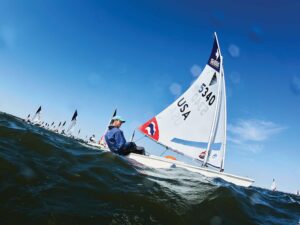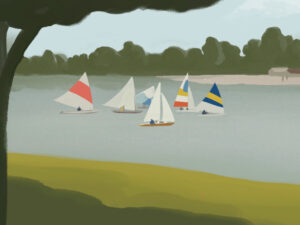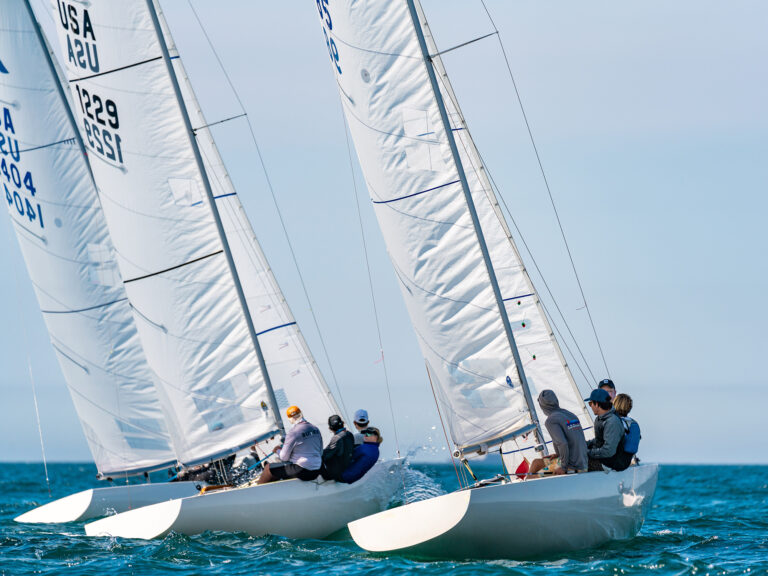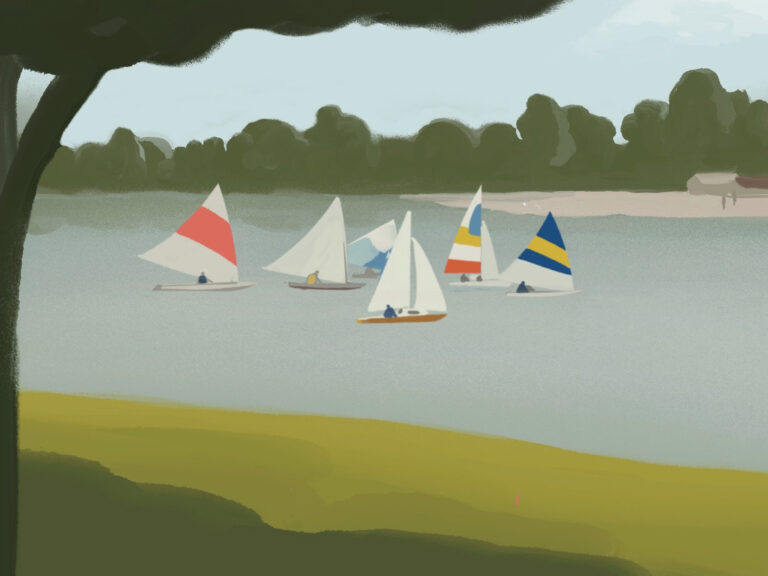IF THE ANNUAL NORTH/SOUTH INTERSECTIONAL WAS just another regatta on the college schedule then thered be no valid reason to move 150 sailors, 60 sailboats, and assorted support staff and equipment to a secluded Southern California lake for the weekend. But the North/South has always been much more than the sum of the race scores, and while-as the last big regatta of the fall season-the competition is fierce, often the memories people take away from this event have only a little to do with how they crossed the finish line.
No other event on the West Coast brings teams together like the North/South. Sailors who usually keep more to themselves at regattas find themselves thrown into a hastily erected shantytown of tents and bonfires, in much closer quarters to their teammates, and other teams, than anywhere else. As the temperature drops into the 30s overnight, friends can always be found where theres a fire. A tradition of the North/South is to center the evening festivities around a large bonfire, with the party lasting until the sailors or the fire fade.
The venue shifts occasionally: This years site is Lake Cachuma, a reservoir nestled in the Santa Ynez Mountains just north of Santa Barbara, Calif. But while the scenery changes, the essence of the regatta remains the same. Each year the two host teams, UC Santa Barbara and Cal Poly San Luis Obispo, invite all the schools in the Pacific Coast Intercollegiate Yacht Racing Association, three teams from the Northwest, and one team from each other district, to a weekend of racing and camping and, well, you never know what else will become part of the final equation.
On this Saturday night, as you walk through the campground, you might stop by the UC San Diego compound, where the team, their friends, and assorted well-wishers are gathered in a circle for a series of extended toasts. Moving over to the UC Irvine campsite, you find several of the competing teams coaches gathered in their rented camper, talking over the days racing while team members crawl on its roof, seeking branches for toasting marshmallows.
At the next group of tents there are the three teams from the Northwest-Washington, Western Washington, and Oregon-which have made the trip south as a group. As if they havent spent enough time together on the 1,000-mile drive, theyre sharing the same campsite for the weekend.
Come spring, these three teams will battle tooth and nail for the districts sole berths in each of the three InterCollegiate Sailing Association North American championships “The drive down to North/South is half the fun,” says University of Washington senior Jason Salvo. “We fight, listen to music, gossip, sleep, and drive each other crazy for 20 hours.”
Twenty schools turn out for the regatta. The varsity portion combines the scores from two FJ and two Laser divisions. The junior varsity fleet is less formal and has unlimited entries; some years this pack has numbered close to 50 FJs. This fleet is always bolstered by several alumni, returning to settle old scores.
UC Irvine alumnus Randy Lake is a regular in the alumni division. A former ICSA singlehanded champion and two-time All-America selection, Lake has nothing to prove but he returns to spar with old friends and trounce the fleet with little apparent effort. “Its good to go back and see what all the different colleges are up to, and just to sail against the same people you used to sail against as an undergrad,” says Lake. As he and so many other alumni have discovered, opportunities like this one-to return to the college sailing scene, jump into a boat, and race like you never left-are few and far between.
“I like how close together all the teams are at the campsite,” says Stanford senior Heather Porter. “Its really our only chance all year to be this close at a regatta.” But as close as teams can become at this event, a shared fireside seat one evening never guarantees any quarter at the leeward mark the following day.
This year, several teams in attendance have their final fall rankings in the forefront of their minds. Parity is on the rise in the West, and the competition on the varsity circle is intense. Hawaii, Stanford, USC, and UC Santa Barbara are all looking to improve their regional and national standings. But by the end of Saturdays racing its Georgetown, one of the out-of-towners, who has the pole position, having taken a slight lead over the pack with solid finishes in all four divisions. Hawaii, five points behind, leads third-place Stanford by a point. One rotation could easily reverse the top three positions.
Sunday morning is never easy at the North/South. The sailors claw their way out of their tents, shivering from the chilly air, and in desperate need of coffee, or maybe aspirin. But then, having regrouped, they get back to racing.
“Sunday morning we didnt even know how close the scores were because they didnt get posted,” says Ken Ward, a junior at Georgetown. “We just wanted to stay consistent. We were doing well enough in all four divisions that we didnt feel like we had to compensate anywhere for a weakness in another fleet.”
In the three-way battle for first, Georgetown extended its lead with a brilliant performance on Sunday, winning races in every division. Hawaii held on to second. There are a few surprises behind the top three. The regattas dark horse is the UC Santa Cruz team, which earns a respectable sixth. Just behind the Banana Slugs-you wont find that mascot at an East Coast college-is the USC team, which doesnt quite perform to its usual standard, finishing eighth after losing a tiebreaker to UC Berkeley.
Like most college regattas the North/South ends quietly. Long drives home and homework assignments move to the fore as soon as the last boat finishes. There isnt much in the way of material rewards for the winners, though the ride home seems shorter after a victory. But even those with the longest road home say that the event was well worth the trip. “Its a really different mentality on the West Coast,” says Ward. “Its good racing, but a more relaxed atmosphere. UCSB really knows how to put on a fun event.”









